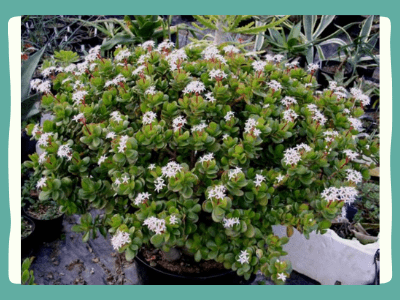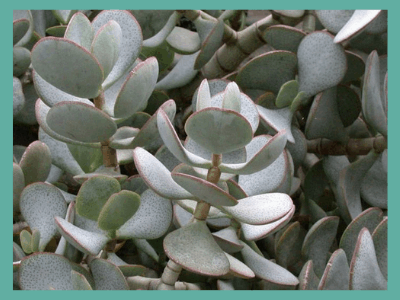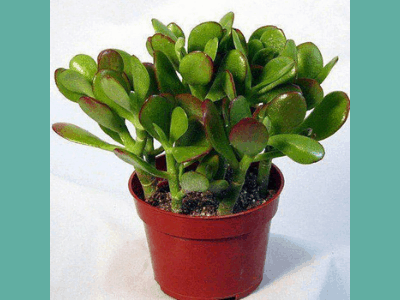The goal of every gardener is definitely to get their plant to bloom, right?
But, again…
It absolutely needs the right care while we are growing it..
The same case goes to Jade Plant. One of the most favorites plant for home gardeners..
…and have been knowns as the ‘money plant’. We often hear, “my jade plant won’t bloom.”
Is it because it won’t bloom? Was your jade plant dying recently? Or are we unaware of its causes and how to deal with them?
I’m sure you know the answer.
One thing for sure…
To get your Jade bloom is indeed easy as long as you know how.
Alright, I will help you to know how to get Jade Plant to bloom?
…by providing information on what may cause a jade plant, not to flower…
,,,, and how to promote blooms in reluctant plants. Before we jump in…
Let’s take a look at Jacqueline’s story below…
I do love gardening a lil bit too much. It just relaxes me to the point…
…where I don’t even realize that I have spent almost 24/7 of my time on my plants…
…even a lot of money was spent. Sadly most of it due to the worry that comes within me…
on the plants that do not grow well It gives a sort of guilty feeling…
How To Get Jade Plant To Bloom?
What’s the bottom line?

credit: https://worldofsucculents.com/tips-get-jade-plant-bloom/
Jade plants are primarily known for their thick, glossy, succulent leaf pads.
There are many types of jade, but the most familiar houseplants are Crassula ovata and Crassula argentea.
These succulents reproduce by vegetative means but can also flower and produce seeds.
Jade plants grow for many years without blooming.
Even in their native habitat, the plants need to be very mature before they form flowers.
Among the many jade plant, flowering requirement is an arid ambient environment.
Interior conditions are often too humid for the plant to form buds.
Getting a jade plant to bloom will require you to remove it to a dry location…
…withhold water, and expose it to cooler nighttime temperatures.
Of course, your plant should be an older species for blooming, or you will still not find a single flower.
Given the right setting and environment, a jade plant is not flowering…
…may simply be that it is not old enough to reproduce yet.
I’m not going to lie to you…
All plants need the same environment they would experience naturally to promote flowering and fruiting.
Some require a dormancy period, some a photoperiod, and others require extreme environmental conditions.
Jade plant flowering requirements are a combination of all three.
The plant doesn’t exactly enter dormancy, but it does require a rest period before buds form.
As the days become shorter, reduce watering and do not fertilize.
Keep the plant in an area of 60 degrees Fahrenheit (12 C.) during fall but protect it from any freezing.
But, here’s the kicker…
Blossoms should start to form around the shortest days of the year and bloom in late winter to early spring.
These starry little flowers are produced in clusters at the tips of branches and are short-lived.
Once the flowers fade and the stalk becomes brown, you can cut off the flowering stem.
Begin to increase water and temperature as the spring progresses.
In summer, move the plant outdoors gradually to an area with some protection from searing sun rays…
…but where it is bright for most of the day. Water when the surface of the soil is dry.
Jade plants like to be crowded…
…so they rarely need repotting to a larger container, but they do need new soil every 3 years.
Repot after the flowers have bloomed and at least a month before you move the plant outdoors for summer.
Use a good cactus mixture for plants left indoors but add a bit of humus-rich soil to plants that are taken outside.
In spring to late summer, fertilize with diluted balanced liquid fertilizers monthly.
Don’t expect annual blooms, however, as the plant needs time to store…
…adequate energy for this infrequent floral spectacle.
Here’s the interesting part…
How To Fertilize It Without Hustle?
Keep in mind that jade plants are not finicky plants.
I consider them to be one of the hardiest succulent plants.
If the potting mix is fresh, fertilizing is usually not necessary.
Once the plant has been sitting in the same potting mix for a couple of years without repotting…
…then you’ll need to replenish the nutrients that the plant would otherwise be getting from fresh soil.
You can use a standard balanced fertilizer for houseplants…
…or a specialized fertilizer designed for succulents and cacti.
Dilute the amount of fertilizer recommended on the package to ¼ or ½ strength.
Be wary of overfeeding jade plants as they are not heavy feeders and do not require that much.
It is best to feed during the growing season, which is in the spring, summer, and fall seasons.
Fertilizing about once a month during the growing season is a good place to start.
During the active growing season, you can fertilize as often as every watering…
…with the fertilizer diluted to ¼ or ½ strength.
Decrease fertilizing as the end of growing season approaches around mid-fall.
Why You Should Never Put Aside These Helpful Wit & Wisdom!
Keep reading…
“To persuade a jade plant to flower, keep it root-bound in a small pot and hold back water. Cooler temperatures in the winter promote blooming, too. Jade plants may reach a height of 6 feet, but as houseplants, they often grow only 18 to 30 inches tall.”
Missouri Botanical Garden.
Jade plants are succulent shrubs that grow to a treelike appearance with a trunk-like stem and fleshy evergreen leaves.
Jade plants have a small and shallow root system, according to North Carolina State University Extension.
Jade plants may be labeled as baby jade, Chinese rubber plant, dwarf rubber plant, jade tree, or Japanese rubber plant.
Adding to potential confusion crassula ovata is synonymous with Crassula argentea…
…and rubber plants are a different genus (Ficus spp., USDA plant hardiness zones 10 through 12).
“An obvious difference, however, is that the jade plant’s fleshy leaves may reach a length of 2 inches. But rubber plant flat leaves are large, leathery and as long as 8 to 12 inches.”
Clemson Cooperative Extension.
Clemson Cooperative Extension further identifies cultivars of Crassula ovata…
…as ‘Bronze Beauty’ (copper jade tree), ‘Sunset’ (gold jade tree), ‘California Red Tip’…
…(red jade tree) and ‘Tricolor’ (tricolor jade). The slow-growing cultivar C. ovata convulta….
…’Hobbit’ (hobbit jade) grows to a maximum of 3 feet.

credit: https://worldofsucculents.com/crassula-arborescens-silver-dollar-plant-chinese-jade/
Crassula arborescens, unlike other Crassula types, have blue-gray leaves with red edges and may be labeled as silver jade plant or bluebird jade.

credit: https://worldofsucculents.com/crassula-arborescens-silver-dollar-plant-chinese-jade/
Crassula ovata flowers appear on mature plants in late winter or early spring.
These small, star-shaped white or pink flowers grow in clusters.
The flowers start as buds covered with pink sepals, which then open.
Two or three clusters of flowers will open when the plant blooms.
As with many other flowering succulent plants, maturity and sunlight are the keys to encouraging jade plant flowers.
Maturity means patience while the plant grows.
Once the plant matures, sunlight becomes the controlling factor for jade plant flowers.
Well, is it true?
Jade plants like at least four hours but prefer six or more hours of full sunlight daily.
Indoors, they grow well with bright filtered light from a south-facing window and two to six hours of direct sunlight.
Jade Plant indoor rarely bloom, however, due to lack of sunlight.
Jade plants grown outdoors with enough sunlight may bloom.
If your jade plant blooms, you’ve found its happy place.
Leave the plant in that spot, and if conditions force you to move the plant into a shelter for the winter…
…then return the plant to that same happy spot when conditions allow.
How To Get Jade Plant to Bloom : The Must-Know Care and Concerns
Here’s the deal…
Propagate jade plants by removing a leaf or stem and placing the broken end in the soil.
Use well-drained loamy soil or cactus mix with some added organic material for jade plants.
Jade plants are susceptible to root rot if the soil stays too wet…
…so delay watering until the top 1 or 2 inches of soil dry, especially after repotting.
Fertilize every three to four months using a liquid household fertilizer…
…but wait four months to fertilize a repotted plant. Jade plants like daytime temperatures…
…of 65 to 75 degrees Fahrenheit and night temperatures of 50 to 55 degrees.
Jade plants don’t go dormant for winter but benefit from a winter rest.
Reduce watering from fall into late winter, protect the plant from drafts, and don’t let leaves touch windows.
As for humidity, jade plants prefer the warmer, drier air found in most homes.
While jade plants don’t mind being root-bound…
…they may reach heights up to 5 feet tall.
Their tree-like structure means that larger plants may become top-heavy and fall over.
When repotting, use a larger, heavier pot to counterbalance the plant.
Another concern with jade plants is toxicity.
While the toxicity risk to humans is low, owners of cats, dogs, and horses should be aware of the risk to their pets.
Recommended Items To Make Your Jade Plants Blooms
- Full of essential nutrients that help feed and nourish above and below the soil
- Contains vital micronutrients to grow stronger, vibrant and more productive plants versus unfed plants
- Feeds up to 3 months
- Will not burn when used as directed
- For use in ground and in containers
- Full of essential nutrients that help feed and nourish above and below the soil
- Contains vital micronutrients to grow stronger, vibrant and more productive plants versus unfed plants
- Feeds up to 3 months
- Will not burn when used as directed
- For use in ground and in contain
Prices pulled from the Amazon Product Advertising API on:
Product prices and availability are accurate as of the date/time indicated and are subject to change. Any price and availability information displayed on [relevant Amazon Site(s), as applicable] at the time of purchase will apply to the purchase of this product.
Let’s sum it all up!
So…
While getting your jade plant to bloom is not a priority, it is definitely a treat to see happy flowers blooming from it.
I have a big jade plant that blooms every year. There is no exact science on how to get them to bloom.
Generally, if you keep your plant healthy and happy by providing proper care and nutrients as mentioned above…
…the plant will naturally bloom when it’s ready.
To encourage blooms, the pants need to be kept in an environment that mimics their natural habitat.
This can be achieved by keeping them cool and dry in the winter months.
You need to decrease watering the plant to a minimum and only water when the soil is dry but not bone dry.
Keep the temperatures cool during the winter months, somewhere between 35-44⁰F (1.5-7⁰C).
Good luck!
Conclusions
I hope this post is able to answer: How to get Jade Plant to bloom?
Now I’d like to know what you have to say.
Do you already know How to get a Jade Plant to bloom? in the easiest and fastest ways….
…that I’m sure they’ve all been underestimated by common people…
If you still have any questions on our topic of How to get a Jade Plant to bloom?
…or even if you need to know more detailed steps to do in dealing with it, feel free to contact me!
Frequently Asked Questions Around How to Get a Jade Plant to Bloom
How Long Does It Take For Jade Plant to Flower?
A jade plant typically takes around 6-8 months to flower…
…but this may vary depending on the size and type of jade plant.
When you see yellow or white petals forming at the top of the stem…
…it is time to start harvesting your flowers.
Be sure not to cut off all of the flowers before they are ready, as this might damage…
…them and decrease their chances of flowering again in future years.
Once you have collected all of your flowers, be sure to dry them properly…
…so that they can be used later.
Jade plants work best when dried slowly over a period of several weeks…
…rather than quickly in an oven or dehydrator.
Once they are completely dry, store them away in a cool place where they will remain healthy and intact for use at a later date.
How Do I Encourage My Jade Plant to Grow?
One of the best ways to encourage your jade plant to grow is by watering it regularly.
Make sure to water it sufficiently so that the soil remains moist but not soggy…
…and avoid overwatering as this can cause root rot.
For a weekly watering schedule, fill a pot halfway with fresh soil and…
…add enough water until the soil is wet but not soaking wet.
Allow the jade plant to soak up plenty of moisture before adding more water.
And finally, fertilize it every few months with an organic fertilizer formulated…
…for plants or mixed into its regular water source.
Do Jade Plants Ever Bloom?
Yes, jade plants can bloom! When they reach the appropriate stage of growth…
…and development, jade plants will produce beautiful flowers that are often…
…used in Chinese culture for healing rituals.
The blooms may last anywhere from a few days to a week, and during this time…
…you’ll likely experience highest levels of energy and prosperity.
If you’re interested in witnessing this event firsthand, be sure to keep an eye out…
…for your jade plant throughout its flowering season.
Where Should Jade Plants be Placed in the House?
Jade plants are typically placed near windows or other areas where they will receive plenty of light.
They also do well in high humidity environments, so be sure to place them…
…near a bathroom or another area where there is often moisture.
What Does a Healthy Jade Plant Looks Like?
Healthy jade plants look NOTHING like the ones you see at your local garden center.
Instead, they are typically small and spindly with a tough exterior.
The leaves may also be variegated in colors such as green, yellow, or white.
Although healthy jade plants can grow up to 6 feet tall, most specimens are…
…much shorter due to their delicate growth habits.
In addition to being beautiful ornamentals, healthy jade plants bear edible…
…fruit that is rich in nutrients and minerals such as calcium, magnesium , potassium , iron , copper , zinc )
This makes them an excellent choice for natural weight loss supplements or overall health maintenance.
Is Jade Plant Good Inside the House?
There is some debate about whether or not jade plant is good inside the house…
…but most people believe that it can be beneficial.
This leafy green plant takes in nutrients from the air and converts them into…
…useful minerals, including potassium and magnesium.
These two minerals are essential for healthy blood pressure levels, nerve function…
…heart rhythm, fatigue management, bowel movements, immune system health…the list goes on!
Additionally, jade contains a compound called tritium, which has been shown to treat…
…conditions such as anxiety and depression.
So while there isn’t conclusive research linking jade with better indoor air quality…
…or health benefits specifically within the home environment, many people find it helpful all around!


